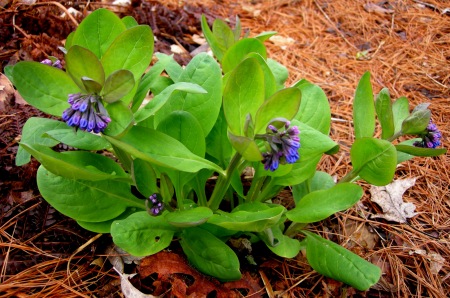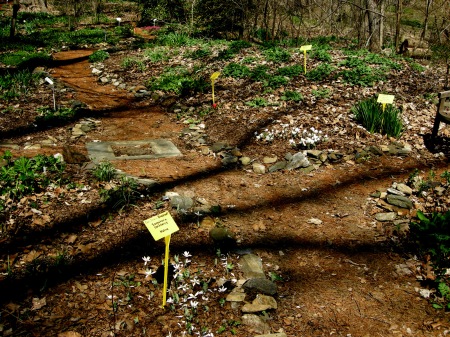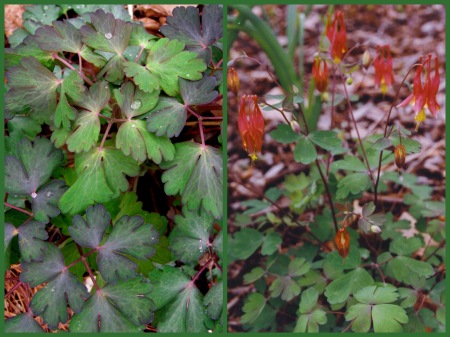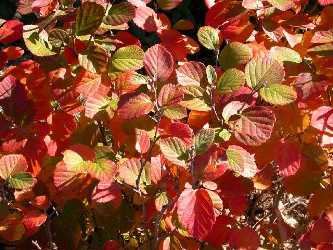Carolyn’s Shade Gardens is a retail nursery located in Bryn Mawr, PA, specializing in showy, colorful, and unusual plants for shade. The only plants that we ship are snowdrops and miniature hostas. For catalogues and announcements of events, please send your full name, location, and phone number (for back up use only) to carolyn@carolynsshadegardens.com. Click here to get to the home page of our website for catalogues and information about our nursery and to subscribe to our blog.
 Annual violas and a hosta I selected called “Carolyn’s Malex II” in a glazed strawberry pot that belonged to my grandfather. There is a different miniature hosta in each of the 16 pockets, and it stays out all winter with no problems for the pot or the hostas. Don’t you love the little faces on the violas?
Annual violas and a hosta I selected called “Carolyn’s Malex II” in a glazed strawberry pot that belonged to my grandfather. There is a different miniature hosta in each of the 16 pockets, and it stays out all winter with no problems for the pot or the hostas. Don’t you love the little faces on the violas?
Over the years, through trial and error, I have discovered some fail safe pairings for the spring shade garden. These plant couples look great together while thriving in the same cultural conditions. Their flower and leaf colors and textures and their habits compliment each other to make pleasing combinations. Plus they are all easy to grow, requiring no watering, staking, or general fussing after they are established in good organic soil in part to full shade.
Hostas that come up early in the spring, especially miniature hostas, play nicely with almost every plant and are extremely easy to grow:
 This pairing is one of my favorite color combinations in the garden. Hosta montana ‘Aureomarginata’ comes up much earlier than other large hostas. Its bright green and yellow leaves serve as the perfect backdrop for the orange and yellow flowers of Epimedium x warleyense.
This pairing is one of my favorite color combinations in the garden. Hosta montana ‘Aureomarginata’ comes up much earlier than other large hostas. Its bright green and yellow leaves serve as the perfect backdrop for the orange and yellow flowers of Epimedium x warleyense.
 Almost all my miniature hostas come out in time to join the blooming epimediums. Here is Epimedium grandiflorum ‘Tama No Gempei’ with Hosta ‘Little Wonder’, but you could choose any epimedium and any miniature hosta for a delightful contrast.
Almost all my miniature hostas come out in time to join the blooming epimediums. Here is Epimedium grandiflorum ‘Tama No Gempei’ with Hosta ‘Little Wonder’, but you could choose any epimedium and any miniature hosta for a delightful contrast.
 A great full shade combination: Hosta ‘Emerald Tiara’ and Japanese woodland primrose, Primula sieboldii (purple form), thrive under my coral bark maple. Japanese woodland primrose is a mat-forming primrose for full, dry shade not to be confused with Japanese primrose, Primula japonica, which requires moist conditions.
A great full shade combination: Hosta ‘Emerald Tiara’ and Japanese woodland primrose, Primula sieboldii (purple form), thrive under my coral bark maple. Japanese woodland primrose is a mat-forming primrose for full, dry shade not to be confused with Japanese primrose, Primula japonica, which requires moist conditions.
 Annual violas and Hosta ‘Crumb Cake’ in a container that stays out all winter. Small containers are a great way to display choice miniature hostas.
Annual violas and Hosta ‘Crumb Cake’ in a container that stays out all winter. Small containers are a great way to display choice miniature hostas.
Another plant whose early spring color goes with just about anything is Spiraea japonica ‘Magic Carpet’. I think I would take this shrub to a dessert island if I had to choose because its deep peach leaves are so gorgeous (and it has fabulous fall color too):
 Dwarf spiraea, Spiraea japonica ‘Magic Carpet, with Italian arum, Arum italicum, and PA (Pennsylvania) native coral bells, Heuchera villosa ‘Caramel’. This is a year round combo because the arum and coral bells remain ornamental through the winter and the spiraea is a solid three-season plant.
Dwarf spiraea, Spiraea japonica ‘Magic Carpet, with Italian arum, Arum italicum, and PA (Pennsylvania) native coral bells, Heuchera villosa ‘Caramel’. This is a year round combo because the arum and coral bells remain ornamental through the winter and the spiraea is a solid three-season plant.
 ‘Magic Carpet’ contrasts nicely with the color and texture of gold-leafed old-fashioned bleeding heart, Dicentra spectabilis ‘Goldheart’. At first I didn’t like the idea of gold and pink together but with careful pairing ‘Goldheart’ is magnificent.
‘Magic Carpet’ contrasts nicely with the color and texture of gold-leafed old-fashioned bleeding heart, Dicentra spectabilis ‘Goldheart’. At first I didn’t like the idea of gold and pink together but with careful pairing ‘Goldheart’ is magnificent.
 You can see some of the gold tones starting to emerge in the new leaves on this ‘Magic Carpet’, which is farther from the house. It looks great with the dark red sedums in this strawberry jar, which also overwinters outside.
You can see some of the gold tones starting to emerge in the new leaves on this ‘Magic Carpet’, which is farther from the house. It looks great with the dark red sedums in this strawberry jar, which also overwinters outside.
 ‘Magic Carpet’ even pairs well with spider webs. Every spring I come out one morning to find all the spiraeas covered with webs.
‘Magic Carpet’ even pairs well with spider webs. Every spring I come out one morning to find all the spiraeas covered with webs.
Here are some more great combinations for early spring:
 I think that PA native Celandine poppy, Stylophorum diphyllum, goes with everything in spring, but it looks especially beautiful with PA native Virginia bluebells, Mertensia virginica.
I think that PA native Celandine poppy, Stylophorum diphyllum, goes with everything in spring, but it looks especially beautiful with PA native Virginia bluebells, Mertensia virginica.
 I am always captivated by the color combination of the buds of Burkwood viburnum, V. x burwoodii ‘Mohawk’, and the flowers of old-fashioned bleeding heart, Dicentra spectabilis. ‘Mohawk’ has fantastic fragrance and spectacular orange-red fall color too. It is a Pennsylvania Horticultural Society gold medal plant.
I am always captivated by the color combination of the buds of Burkwood viburnum, V. x burwoodii ‘Mohawk’, and the flowers of old-fashioned bleeding heart, Dicentra spectabilis. ‘Mohawk’ has fantastic fragrance and spectacular orange-red fall color too. It is a Pennsylvania Horticultural Society gold medal plant.
 The airy bronze foliage and yellow flowers of fern-leafed corydalis, Corydalis cheilanthifolia, perfectly compliment the flower color of this 18th century heirloom primrose, Primula x polyantha ‘Old Brick Reds’.
The airy bronze foliage and yellow flowers of fern-leafed corydalis, Corydalis cheilanthifolia, perfectly compliment the flower color of this 18th century heirloom primrose, Primula x polyantha ‘Old Brick Reds’.
Pulmonarias (lungwort) go with just about anything too:
 The early blue flowers and narrow silver leaves of Pulmonaria ‘Diana Clare’ with the abundant pink flowers and silver-striped leaves of Lamium maculatum ‘Shell Pink’, which blooms from April until November and has evergreen foliage. Pulmonarias also keep their beautiful leaves well into the winter.
The early blue flowers and narrow silver leaves of Pulmonaria ‘Diana Clare’ with the abundant pink flowers and silver-striped leaves of Lamium maculatum ‘Shell Pink’, which blooms from April until November and has evergreen foliage. Pulmonarias also keep their beautiful leaves well into the winter.
 I have collected over 25 varieties of pulmonaria, but then I let them self sow all over my garden with glorious results. Above is a pink seedling pulmonaria with very rare Helleborus dumetorum subsp. atrorubens, but any red flowered hybrid hellebore would complete the pair.
I have collected over 25 varieties of pulmonaria, but then I let them self sow all over my garden with glorious results. Above is a pink seedling pulmonaria with very rare Helleborus dumetorum subsp. atrorubens, but any red flowered hybrid hellebore would complete the pair.
 More seedling pulmonarias paired with a purple strain of Lamium maculatum ‘Shell Pink’.
More seedling pulmonarias paired with a purple strain of Lamium maculatum ‘Shell Pink’.
 PA native wild ginger, Asarum canadense, and PA native dwarf Jacob’s ladder, Polemonium reptans, carpet my woodlands in early spring. Together they produce a subtle and peaceful beauty.
PA native wild ginger, Asarum canadense, and PA native dwarf Jacob’s ladder, Polemonium reptans, carpet my woodlands in early spring. Together they produce a subtle and peaceful beauty.
 I never thought of cushion spurge, Euphorbia polychroma, as a shade plant but it actually thrives in quite a bit of shade: here with hybrid hellebore, H. x hybridus ‘Metallic Blue Lady’. I also love the cushion spurge cultivar ‘Bonfire’ with red leaves.
I never thought of cushion spurge, Euphorbia polychroma, as a shade plant but it actually thrives in quite a bit of shade: here with hybrid hellebore, H. x hybridus ‘Metallic Blue Lady’. I also love the cushion spurge cultivar ‘Bonfire’ with red leaves.
 I think this is one of the most beautiful combinations in my early spring garden, and it took me over 50 attempted photographs to capture it on film! Siberian bugloss, Brunnera macrophylla, cowslip primrose, Primula veris, and spring starflower, Ipheion uniflorum.
I think this is one of the most beautiful combinations in my early spring garden, and it took me over 50 attempted photographs to capture it on film! Siberian bugloss, Brunnera macrophylla, cowslip primrose, Primula veris, and spring starflower, Ipheion uniflorum.
 Same as above with Ajuga reptans ‘Metallica’.
Same as above with Ajuga reptans ‘Metallica’.
 I will finish my spring combinations with something for all you sunny gardeners: white stonecrop, Sedum album, with tulip ‘Little Princess’.
I will finish my spring combinations with something for all you sunny gardeners: white stonecrop, Sedum album, with tulip ‘Little Princess’.
I hope I have given you some ideas for creative combinations to add to your spring garden. Please leave a comment/reply with some favorite pairs from your own garden.
Carolyn
Notes: Every word that appears in orange on my blog is a link that you can click for more information. If you want to return to my blog’s homepage to access the sidebar information (catalogues, previous articles, etc.), just click here.
Nursery Happenings: My second annual Great Hosta Blowout is going on right now. For details, click here. Look for Carolyn’s Shade Gardens at the Bryn Mawr Farmer’s Market on Saturday, May 7, from 9 am to 1 pm . My next open house sale is Saturday, May 14, from 10 am to 3 pm.



























































































